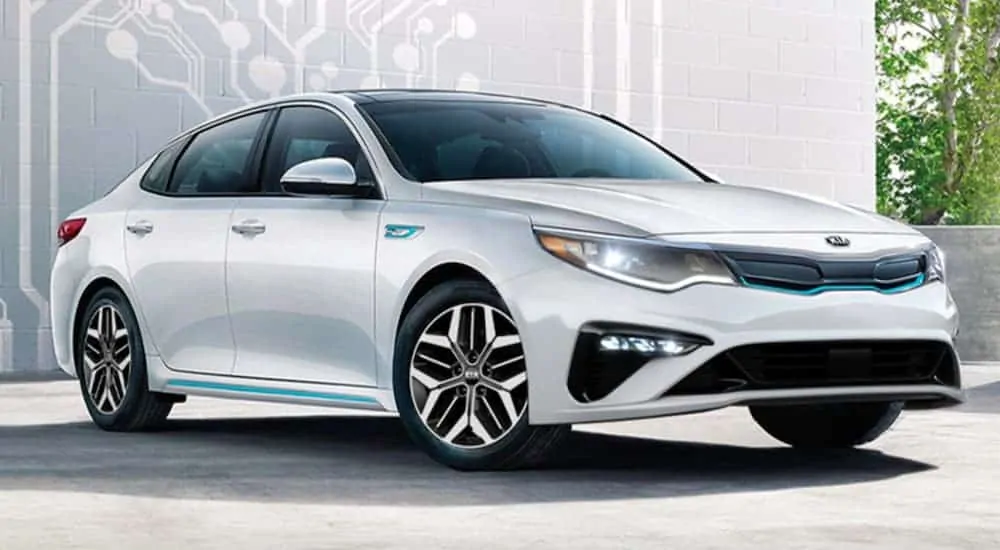In 2020, there are mid-size sedans on the market available with gas, hybrid, and plug-in hybrid options. This trend in the automotive industry is mostly below-the-radar to the public, and that includes fellow car-junkies and gearheads. These choices allow for a fantastic range of options within a given model, not just of exterior or interior features, bells, or whistles, but of the driving lifestyle you wish to lead. And you don’t even have to consider a change of model. That’s pretty cool. If you are interested in having those types of options, the Kia Optima and the Ford Fusion are probably where you should be looking. But which one is better? To help you decide, here is a comparison: 2020 Kia Optima vs 2020 Ford Fusion.
Optima vs Fusion Trims
The Kia Optima starts at an MSRP of $23,390 with the lowest, LX trim. Then there is the S, starting at $24,890; the Special Edition, starting at $26,390; the EX starting at $27,190; the Hybrid EX starting at $29,310; the EX Premium starting at $30,190; and finally, the SX with a beginning MSRP of $32,190. There are many different trims – including a hybrid option at extremely affordable prices.
The Ford Fusion has one more trim option than the Kia Optima because there is a plug-in hybrid option. Starting from the lowest trim, the Fusion has an S trim with an MSRP of $23,170. After that the Fusion has the SE, beginning at $24,500; the Hybrid SE at $28,000; the SEL at $28,690; the Hybrid SEL starting at $31,630; the Titanium, beginning at $34,450; the Hybrid Titanium at $34,595; and last but not least, the Plug-In Hybrid Titanium starting at $35,000.
As you go higher in trims for both the Optima and the Fusion, more features become available. The engine gets more powerful, and safety features become more plentiful. While it may seem Ford is offering more with the Plug-In Hybrid Titanium trim, it is important to note that this vehicle needs to be charged. Unless you live somewhere with public chargers, or you are willing to invest in an at-home charger for your vehicle, this would not be a good option. Overall, based on the number of trims and prices, the 2020 Kia Optima and 2020 Ford Fusion are on the same level.

Performance and Efficiency
The Kia Optima has four different engine types, including the hybrid set-up. The first engine is used in the LX, S, and Special edition trims. It is a 2.4L, 4-cylinder engine that puts out 185 hp with 178 lb-ft of torque. The second is a turbocharged 1.6L, 4-cylinder providing 178 hp and 195 lb-ft of torque, used in the EX and EX Premium trims. Then, used in the SX trim, is a turbocharged 2.0L, 4-cylinder engine with 245 hp and 260 lb-ft of torque. The hybrid set-up is a bit different as it utilizes a regular engine and an electric motor. The engine itself is a 2.0L, 4-cylinder engine with 145 hp and 140 lb-ft of torque. The motor, an Interior-Permanent Magnet Synchronous Motor, has 50.9 hp and 151 lb-ft of torque. This means that overall, the hybrid puts out 192 hp with 271 lb-ft of torque.
Also significant when looking at mid-size sedans is the gas mileage. The Optima LX has good fuel efficiency at 25 MPG in the city, 35 MPG on the highway. The S and Special Edition are 24 MPG city and 32 MPG highway. EX and EX Premium have fantastic gas mileage at 27 MPG in the city and 37 MPG highway. The SX trim drives with 21 MPG city and 30 MPG highway. Of course, the best fuel efficiency comes from the EX Hybrid at 40 MPG in the city and 45 MPG on the highway.
The Ford Fusion also has four different engine types, including those in the hybrid vehicles. First, there is the 2.5L i-VCT engine that is used in the S trim and gives 175 hp with 175 lb-ft of torque. Next, there is a 1.5L EcoBoost engine with 181 hp and 185 lb-ft of torque that is standard on the SE and SEL trims. Next, available as optional on the SE and standard on the Titanium is a 2.0L Ecoboost engine that provides 245 hp and 275 lb-ft of torque. All of the hybrid vehicles have the same 2.0L i-VCT Atkinson-cycle hybrid engine and electric motor set-up with 188 hp and 129 lb-ft of torque.
The fuel efficiency for the Fusion starts with 21 MPG city and 31 MPG highway for the S and Titanium trims. The SE and SEL trims have fuel efficiency of 23 MPG city and 34 MPG highway. All of the regular hybrids have 43 MPG city with 41 MPG highway. And of course, the plug-in hybrid has significantly higher numbers at 109 MPG city and 97 MPG highway. But remember that this vehicle needs to be charged, which can be very inconvenient.
First and foremost, it is good to point out that the lowest trim engine is strong in the Optima than it is in the Fusion. Plus, the hybrid that Kia offers has a much stronger engine and motor combination than Ford does. Plus, besides the plug-in hybrid from Ford, the fuel efficiency numbers are much better on the Optima than the Fusion. Between engine performance and fuel efficiency, the Optima clearly has the upper hand.
Optima and Fusion Safety
No matter what power or features come in a vehicle, the most important part of driving will always be safety. Nothing else matters if you are not safe. These days, technology has contributed tons to making vehicles safer with all kinds of features. Let’s look at which of these features are used in the Kia Optima and Ford Fusion.
The Kia Optima has tons of standard safety features because safety is important to Kia. Special technology features standard across the board in the Optima are blind-spot collision warning, parking-distance warning, lane-change assist, rear cross-traffic warning, forward collision warning, lane departure warning, and lane-keeping assist. These features are not often standard and usually require upgrades to get in vehicles. However, Kia has included them in every trim to keep all drivers safe. If you do decide to upgrade to the EX trim or higher, you will also get Smart Cruise Control, which is just like regular cruise control except it has stop and go so that you can stay in cruise control when you hit traffic.
The Fusion comes with Ford Co-Pilot360 Technology. All regular trims come standard with a rear-view camera, lane-keeping assist, AdvanceTrac with electronic stability control, and SOS Post-Crash Alert. The hybrid trims come standard with only the lane-keeping assist, rear-view camera, and SOS Post-Crash Alert.
It is clear that the Kia Optima has a ton of more safety features than the Ford Fusion. With features like blind-spot collision warning, and rear cross-traffic warning, the Optima is truly optimizing technology to make for the safest vehicle possible. That being said, in the comparison of safety features, the Kia Optima is the obvious winner.
Conclusion
While the competition was tight in some areas, the Kia Optima is the overall winner of this comparison. With some better engines, the best fuel-efficiency, and far more standard safety features, it is only fair that the winning title goes to Kia. So next time you are in the market for a mid-size sedan, check out the 2020 Kia Optima.





